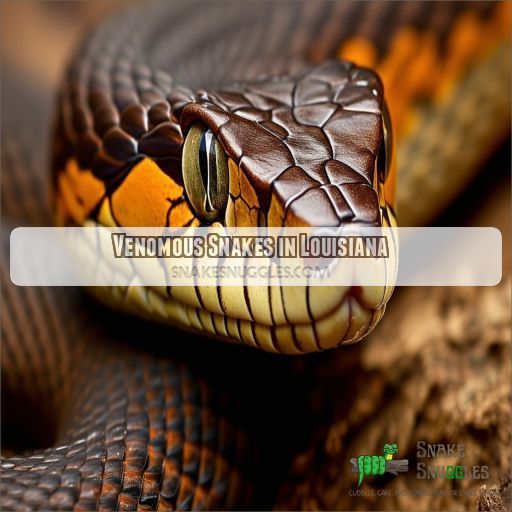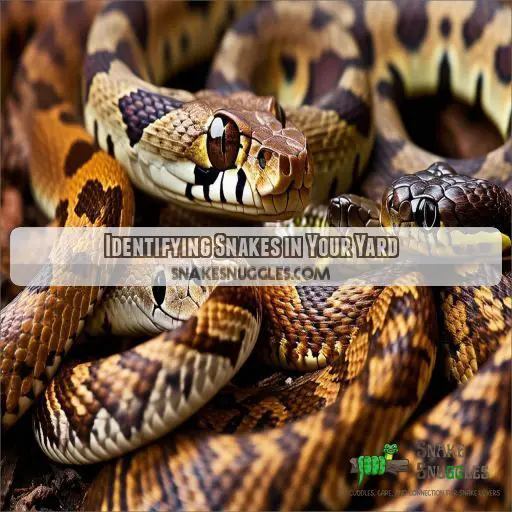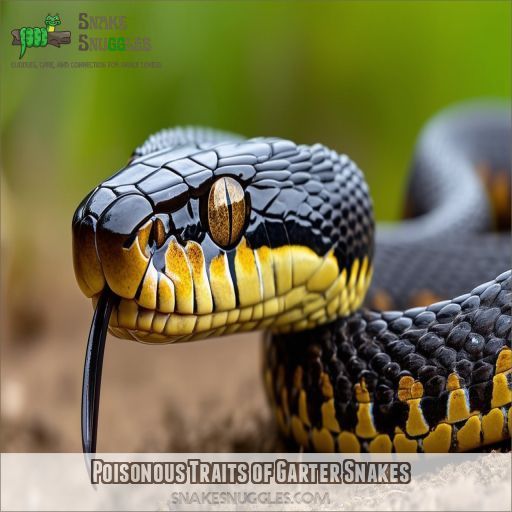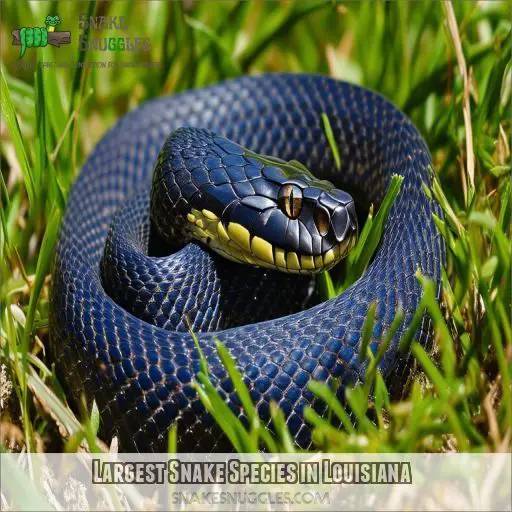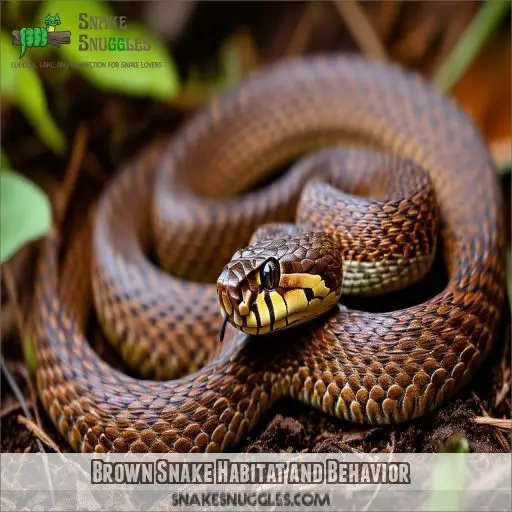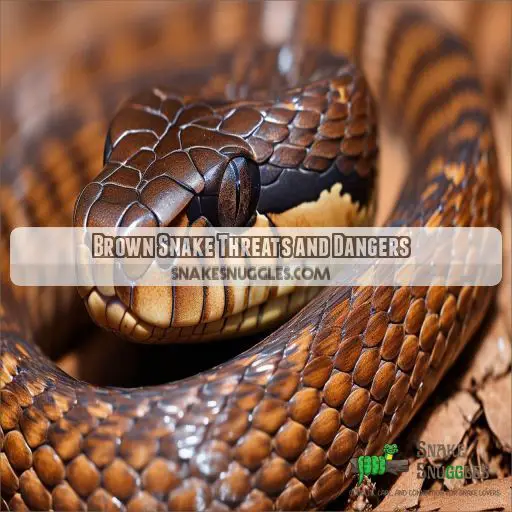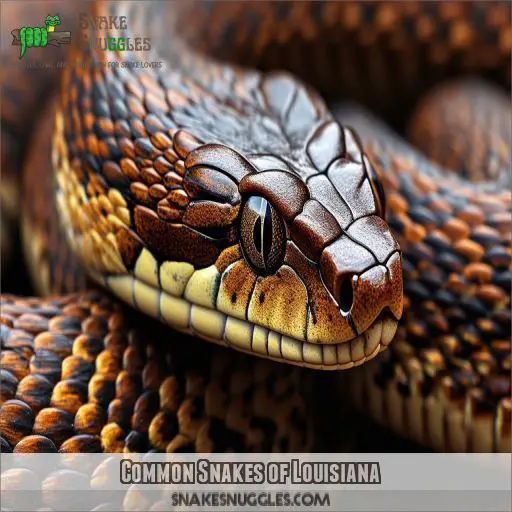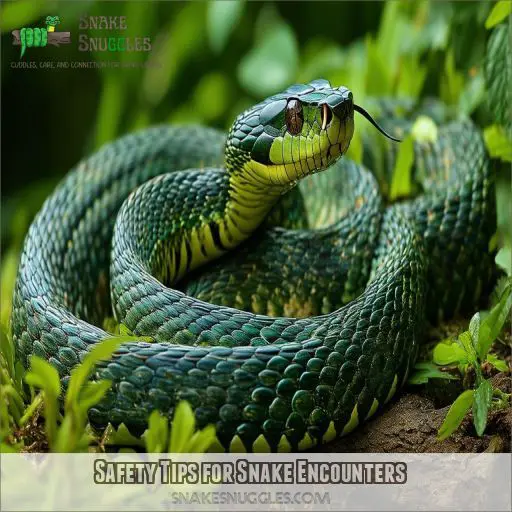This site is supported by our readers. We may earn a commission, at no cost to you, if you purchase through links.
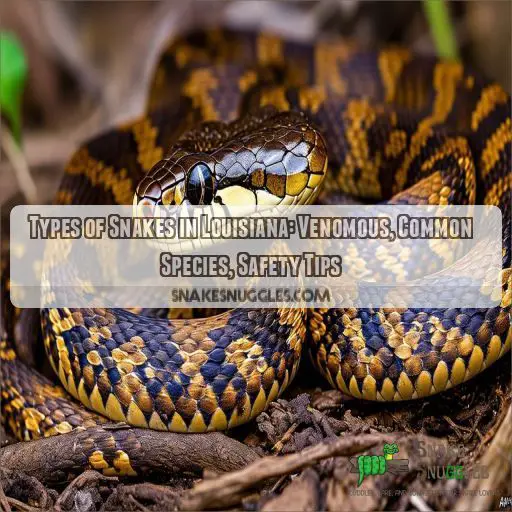
Understanding the types of snakes that call Louisiana home—from some really venomous vipers to harmless but very interesting common species—is part of staying safe and out of curiosity.
You will be able to recognize these slithering residents and their habitats, along with ways to handle such encounters.
Learn through this handy guide to in-depth pointers and safety tips to keep in mind while moving within the reptilian landscape of Louisiana.
Table Of Contents
- Key Takeaways
- Venomous Snakes in Louisiana
- Identifying Snakes in Your Yard
- Poisonous Traits of Garter Snakes
- Largest Snake Species in Louisiana
- Brown Snake Habitat and Behavior
- Brown Snake Threats and Dangers
- Common Snakes of Louisiana
- Iconic Non-Venomous Snakes
- Safety Tips for Snake Encounters
- Frequently Asked Questions (FAQs)
- Are there any poisonous snakes in Louisiana?
- How do I identify a snake in my yard?
- Are garter snakes in Louisiana poisonous?
- What is the largest snake species in Louisiana?
- How do snakes hunt in Louisiana?
- What are Louisianas rarest snake species?
- How do snakes benefit Louisianas ecosystem?
- What adaptations help Louisiana snakes survive floods?
- Are there any invasive snake species in Louisiana?
- Conclusion
Key Takeaways
- Get ready for a wild ride through Louisiana’s snake world! From venomous Pit vipers like cottonmouths and rattlesnakes to harmless garter snakes with their vibrant stripes, you’ll meet a diverse cast of slithering characters.
- When in snake territory, stay vigilant like a hawk! Wear sturdy shoes and stick to clear paths to avoid any unexpected encounters. Remember, snakes aren’t too keen on human company, so give them their space and you’ll be golden.
- If you do cross paths with a snake, don’t panic like a headless chicken! Keep your distance and observe it from afar. Snakes are generally shy and would rather avoid a confrontation, so let them slither away in peace.
- Louisiana’s snakes play a vital role in keeping the ecosystem in balance. They’re like the unsung heroes of nature, controlling rodent populations and even helping plants spread their seeds. So, next time you see a snake, appreciate its contribution to the wild tapestry of Louisiana’s ecosystem.
Venomous Snakes in Louisiana
Louisiana is home to several venomous snakes, including the northern cottonmouth, eastern copperhead, eastern diamond-back rattlesnake, pygmy rattlesnake, and timber rattlesnake. Understanding these species can keep you safe.
Pit vipers, like the cottonmouth and copperhead, have slit-shaped eyes and wide, flattened heads. The eastern diamond-back, known for its distinctive diamond-shaped markings, and the pygmy rattlesnake, with dark blotches, are also pit vipers. Their bites can be dangerous, causing severe pain and tissue damage.
Practices for snakebite prevention include wearing sturdy shoes, avoiding dense underbrush, and being vigilant near swamps, lakes, or wooded areas. Remember, these snakes generally avoid humans and will only bite if threatened.
Identifying Snakes in Your Yard
Identification of yard snakes is very critical. Most Louisiana environments host both venomous and harmless snakes. Most species can be matched to hood color patterns, head shapes, and behaviors.
The dangerous Eastern Diamondback will have diamonds with a broad, flat head. Harmless Kingsnakes have round heads with color bands that are variable.
Keep your yard clean of any debris and overgrown vegetation, as this can attract unwanted guests like snakes. To avoid snake bites, wear sturdy shoes. Use paths, watch your step, and never approach a snake whose identification you’re unsure of.
Get to know the everyday species around you so that you’ll be able to recognize a possibly dangerous snake if it’s in your yard.
Poisonous Traits of Garter Snakes
Now, the next to go through in your Louisiana yard snakes is getting to know the uniqueness of the garter snake. While they aren’t known as venomous, these types of snakes have some very interesting characteristics to them.
First, garter snakes are carnivorous, which means they eat a variety of small prey, from rodents and frogs to other snakes. This diet assist in keeping the populations of potential pests under control around your home. Second, garter snakes bear live babies; females can give birth to litters of as many as 10-50 babies at a time. By adopting this strategy of reproduction, garter snakes are able to thrive in almost all types of habitats. Garter snakes are important conservation indicators; their presence indicates a healthy ecosystem. Learning about these snakes will increase your appreciation for the role they play in Louisiana’s natural landscapes.
Largest Snake Species in Louisiana
When diving into the largest snake species in Louisiana the Eastern Diamond-back Rattlesnake often tops the list. This pit viper can grow up to 90 inches in length and weigh around 10 pounds. Its diet includes small mammals, birds, and sometimes reptiles. Breeding occurs in late summer, with females birthing live young.
Though impressive, Eastern Diamond-backs face predators such as hawks, larger mammals, and even humans. These snakes are important for controlling pest populations but are venomous and should be respected from a distance.
Note that while the Eastern Diamond-back Rattlesnake is the largest venomous snake, non-venomous options like the Rat Snake also reach considerable sizes, contributing to Louisiana’s diverse and fascinating snake population.
Brown Snake Habitat and Behavior
From the largest snake species, like the Eastern Indigo biggest snakes in US, let’s discuss their habitat and behavior
. These unobtrusive reptiles are everywhere—from woodsy lands to open fields.
Dieting mostly on small rodents, amphibians, and insects, these snakes are quite helpful in keeping pesky populations under control.
As far as reproduction goes, brown snakes are live bearers; usually, their litters prevail in the range of 5-20 young. The average lifespan is around 5-10 years, but they’ve plenty of natural predators, like hawks, raccoons, and other large snakes.
As a result of this number of dangers against them, various conservation measures had to be authorized concerning the safeguard of these brown snake populations in sustaining that delicate balance of Louisiana ecosystems.
Brown Snake Threats and Dangers
While they aren’t particularly aggressive, there’s still some danger in a brown snake’s bite. Their venom isn’t deadly to humans, although it can cause pain, swelling, and redness locally. Yet, seek immediate medical care if bitten because severe infections and allergic reactions could occur.
Fortunately, the brown snake populations are stable, and they play a vital role in keeping rodent populations under control. The trouble is, their territory overlaps with humans, which can occasionally cause unpleasant encounters.
It’s always better to be cautious, even with nonpoisonous ones like water snakes and corn snakes. Maintaining a respectful distance and resisting the urge to handle them are the best ways to stay safe. Proper precautions** allow us to peacefully coexist with these amazing reptiles.
Common Snakes of Louisiana
When you’re exploring Louisiana’s diverse environments, encounter several common snakes. Garter Snakes, an example of evolutionary adaptability, feature three to five vertical stripes and thrive in various habitats. Water Snakes have a robust build and primarily feed on fish and amphibians. The North American Racer is known for its impressive speed, identifiable by its gray or brown body and yellow underside. Banded Watersnakes are prolific breeders and are found near water sources. Western Ribbon Snakes, preferring moist locations, are also prevalent throughout the state.
| Species | Unique Traits | Habitat |
|---|---|---|
| Garter Snake | Stripes, evolutionary adaptability | Diverse |
| Water Snake | Robust, fish and amphibian diet | Near water |
| North American Racer | Speed, distinct coloration | Open areas |
| Banded Watersnake | High reproductive rate, water sources | Aquatic environments |
| Western Ribbon Snake | Moisture-preferring, slender body | Wetlands |
Use this guide to stay informed and aware of Louisiana’s diverse snake population.
Iconic Non-Venomous Snakes
You’ll find a few absolutely emblematic non-venomous snakes crawling around the wilds of Louisiana. For instance, kingsnakes are muscular habitat generalists in an array of colors that are basically captivating.
Common in forested areas, the Louisiana Pine Snake reaches as much as three feet in length.
Ratsnakes are slender and powerful, brown and tan to red and orange in color. The prairie kingsnake, found statewide, reaches a length of up to 60 inches.
Statewide, too, is the eastern milksnake, also having a maximum length of 60 inches. These two lovely non-venomous snakes fill important niches within Louisiana ecosystems, and how to identify them enhances one’s enjoyment of the wide array of reptilian life found in our state.
Safety Tips for Snake Encounters
To safely navigate encounters with Louisiana’s snakes, these essential guidelines.
- Stay alert: Wear sturdy shoes and stick to well-trodden paths to avoid stumbling upon snakes in dense vegetation. Your safety during a snake encounter begins with awareness.
- Maintain distance: Most snakes, including venomous species, prefer to avoid human interaction. Respect their space and observe from afar to reduce the risk of bites.
- Protect your pets: Keep pets on leashes, especially near swamplands or wooded areas, as they may provoke defensive behavior from snakes.
- Be prepared: Familiarize yourself with identifying features of local species and emergency contacts for poison control.
These steps enhance your safety and promote snake conservation by minimizing harmful interactions.
Frequently Asked Questions (FAQs)
Are there any poisonous snakes in Louisiana?
Yes, Louisiana has poisonous snakes. You’ll find pit vipers like the Cottonmouth, Copperhead, and various rattlesnakes, along with the Harlequin Coral Snake. These snakes inhabit forests, swamps, lakes, and upland areas.
How do I identify a snake in my yard?
To identify a snake in your yard, check length, color, pattern, head shape, and pupil type. Note its, habitat, and markings. For Louisiana, use distinctive features of local venomous and non-venomous species.
Are garter snakes in Louisiana poisonous?
No, garter snakes in Louisiana aren’t poisonous. They’re harmless and have a characteristic striped appearance to them; they’re also of an overall length that makes them quite easy to handle. These snakes are very helpful at keeping pest populations under control, so it’s best to just leave them alone.
What is the largest snake species in Louisiana?
The largest snake species in Louisiana is the Eastern-back Rattlesnake, reaching up to 90 inches in length. find it in dry, wooded areas and upland habitats, known for its diamond-shaped markings.
How do snakes hunt in Louisiana?
Snakes in Louisiana are cunning predators, stalking their prey with stealth and precision. They employ a range of hunting strategies, from ambush to active pursuit, to capture small mammals, birds, and other reptiles with deadly efficiency.
What are Louisianas rarest snake species?
Louisiana’s rarest snake species include the Pine Snake, an elusive inhabitant of forested regions, and the Harlequin Coralsnake, known for being secretive and rarely seen. Both species face habitat threats, making sightings rare.
How do snakes benefit Louisianas ecosystem?
Though seemingly unsung heroes of the Pelican State’s ecosystem, snakes have played fundamental roles in Louisiana by being important predators, prey items, and even ecosystem engineers. (Source) Many not only keep rodent numbers within manageable levels but also help in seed dispersal, thus helping to maintain balance in Louisiana’s natural habitats.
What adaptations help Louisiana snakes survive floods?
Louisiana snakes adapt to floods by seeking higher, using their swimming abilities to navigate water, and utilizing burrows. Their survival hinges on flexibility in behavior, seeking refuge in trees or elevated areas during high water levels.
Are there any invasive snake species in Louisiana?
While Louisiana is home to diverse native snakes, you’ll be relieved to know there are no established invasive snake species causing problems in the state. The native reptiles have the habitat and resources they need to thrive.
Conclusion
Explore Louisiana’s reptilian landscape and learn about the different species that make up this very essential part of the ecosystem. Knowing what snakes inhabit Louisiana, along with their habitats and behaviors, is important for ensuring safety while improving your outdoor experience.
A snake encounter requires you to remember being aware of the common species, identification of dangerous ones, and some safety tips to come back safe and enjoy nature in Louisiana.

